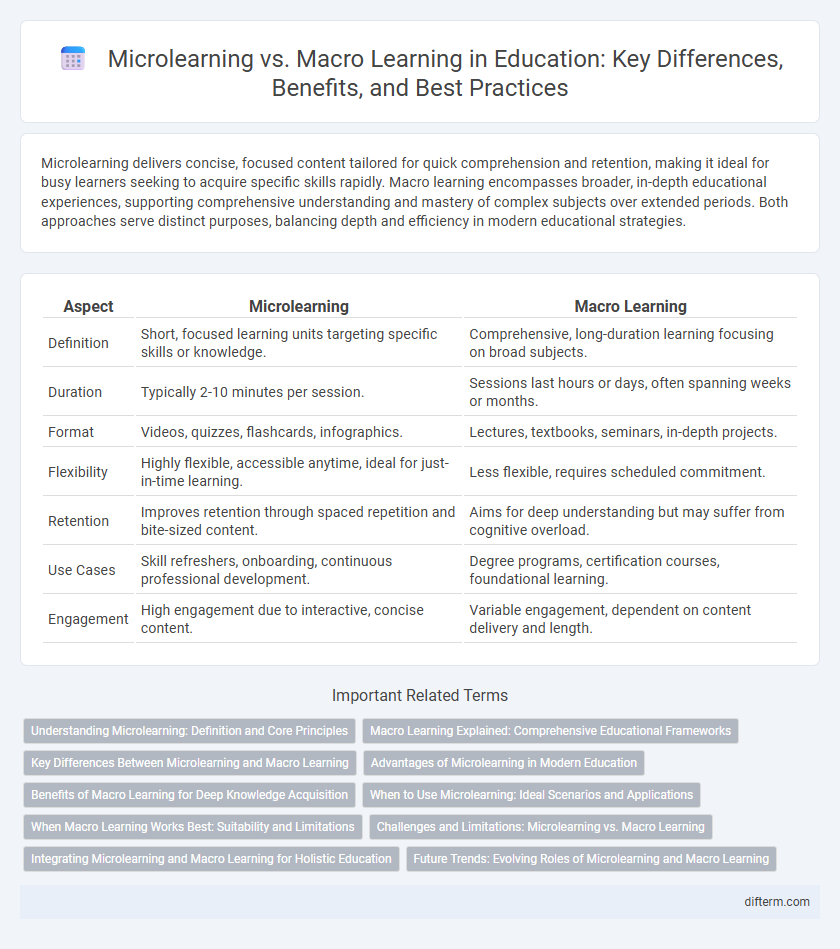Microlearning delivers concise, focused content tailored for quick comprehension and retention, making it ideal for busy learners seeking to acquire specific skills rapidly. Macro learning encompasses broader, in-depth educational experiences, supporting comprehensive understanding and mastery of complex subjects over extended periods. Both approaches serve distinct purposes, balancing depth and efficiency in modern educational strategies.
Table of Comparison
| Aspect | Microlearning | Macro Learning |
|---|---|---|
| Definition | Short, focused learning units targeting specific skills or knowledge. | Comprehensive, long-duration learning focusing on broad subjects. |
| Duration | Typically 2-10 minutes per session. | Sessions last hours or days, often spanning weeks or months. |
| Format | Videos, quizzes, flashcards, infographics. | Lectures, textbooks, seminars, in-depth projects. |
| Flexibility | Highly flexible, accessible anytime, ideal for just-in-time learning. | Less flexible, requires scheduled commitment. |
| Retention | Improves retention through spaced repetition and bite-sized content. | Aims for deep understanding but may suffer from cognitive overload. |
| Use Cases | Skill refreshers, onboarding, continuous professional development. | Degree programs, certification courses, foundational learning. |
| Engagement | High engagement due to interactive, concise content. | Variable engagement, dependent on content delivery and length. |
Understanding Microlearning: Definition and Core Principles
Microlearning is an educational approach that delivers content in small, focused segments, typically lasting between two to ten minutes, designed to enhance retention and engagement. It emphasizes personalized, on-demand learning experiences that fit easily into learners' schedules, leveraging multimedia elements such as videos, quizzes, and infographics to cater to diverse learning styles. Core principles include brevity, relevance, and interactivity, making microlearning an effective strategy for skill acquisition and knowledge reinforcement in dynamic learning environments.
Macro Learning Explained: Comprehensive Educational Frameworks
Macro learning encompasses comprehensive educational frameworks that deliver in-depth knowledge through extended curriculum designs, allowing learners to grasp complex concepts and develop critical thinking skills over time. It integrates various learning modules, assessments, and real-world applications to ensure a holistic understanding of subject matter. This approach contrasts with microlearning by prioritizing breadth and long-term retention essential for professional or academic mastery.
Key Differences Between Microlearning and Macro Learning
Microlearning delivers focused, bite-sized content designed for quick consumption and immediate application, typically lasting from a few seconds to 15 minutes. Macro learning encompasses comprehensive, in-depth study sessions that cover broader topics over extended periods, often several hours or days. Key differences include content length, learner engagement strategies, and adaptability to busy schedules, with microlearning promoting just-in-time knowledge and macro learning fostering deep understanding and retention.
Advantages of Microlearning in Modern Education
Microlearning enhances retention and engagement by delivering content in short, focused segments that fit easily into learners' busy schedules. This approach supports personalized learning paths through adaptive technology, enabling immediate application of knowledge and improved skill acquisition. The flexibility and accessibility of microlearning modules make them ideal for modern educational environments, catering to diverse learner needs and promoting continuous development.
Benefits of Macro Learning for Deep Knowledge Acquisition
Macro learning supports deep knowledge acquisition by providing comprehensive context and allowing learners to explore complex concepts in detail. It fosters critical thinking and long-term retention through extended engagement with material, often spanning multiple sessions or modules. This method is especially effective for mastering intricate subjects that require interconnected understanding and skill development.
When to Use Microlearning: Ideal Scenarios and Applications
Microlearning is ideal for delivering focused, short bursts of information in scenarios requiring rapid skill acquisition, just-in-time training, or reinforcement of specific concepts. It excels in environments like employee onboarding, compliance updates, and mobile learning where learners benefit from concise, easily digestible content. This approach supports continuous learning by breaking complex topics into manageable segments, enhancing retention and application in real-world tasks.
When Macro Learning Works Best: Suitability and Limitations
Macro learning works best for complex subjects requiring deep understanding and long-term retention, such as advanced mathematics or language acquisition. It is suitable for learners who have extended time for study and need comprehensive, structured content that builds foundational knowledge. However, macro learning can be less effective for just-in-time training or rapidly changing information where quick, targeted microlearning modules provide more flexibility.
Challenges and Limitations: Microlearning vs. Macro Learning
Microlearning faces challenges such as limited depth in complex subjects and potential fragmentation of knowledge, which can hinder comprehensive understanding. Macro learning, while offering thorough coverage, often demands significant time investment and may reduce learner engagement due to its length and complexity. Both approaches require careful integration to balance content retention, learner motivation, and curriculum cohesiveness in educational environments.
Integrating Microlearning and Macro Learning for Holistic Education
Integrating microlearning and macro learning creates a comprehensive education framework that balances focused, bite-sized content with broader, in-depth knowledge acquisition. Microlearning enhances retention through targeted, short lessons while macro learning fosters critical thinking and complex problem-solving by exploring subjects extensively. Leveraging both approaches optimizes learner engagement, supports diverse learning styles, and promotes mastery across various educational domains.
Future Trends: Evolving Roles of Microlearning and Macro Learning
Microlearning is poised to dominate future educational trends due to its flexibility and bite-sized content tailored for rapid skill acquisition, ideal for digital and mobile learning environments. Macro learning remains essential for comprehensive subject mastery and critical thinking development in formal education and professional training programs. Integration of AI and adaptive learning technologies will enable personalized blending of microlearning and macro learning, enhancing learner engagement and efficacy across diverse disciplines.
microlearning vs macro learning Infographic

 difterm.com
difterm.com